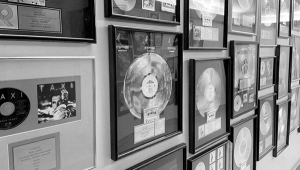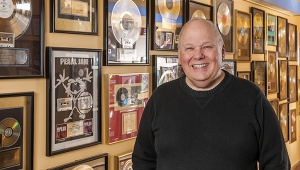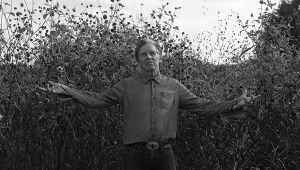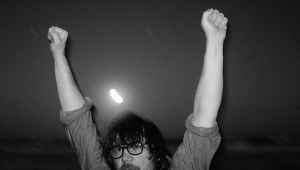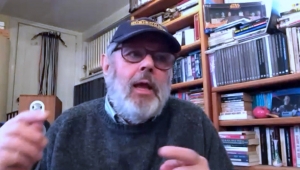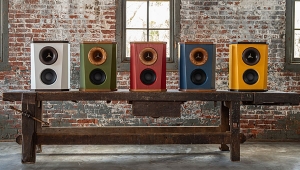| Columns Retired Columns & Blogs |
Home-Grown: Michael Kelly of Aerial Acoustics
To get some background information both on Aerial Acoustics and on the 10T loudspeaker that I review this month, I gave Aerial's Michael Kelly a call. When had he got involved in loudspeakers, I asked...
Michael Kelly: My BS was in Physics; I studied Plasma Physics at the postgraduate level, but did not complete my doctorate. Then I got involved in audio—I worked for a/d/s/ from 1974 to '86. I was Executive Vice-President in R&D and Manufacturing when I left to go to MIT, where I was a Sloane Fellow...
Wes Phillips: Oh, the school, not the cable company!
Kelly: [heh-heh] Yes, that's right! That was a wonderful experience—the Sloane Fellowship is a complete, very complete Masters in Business. After that I did a little bit of design work for Boston Acoustics and B&W. I even put in a stint at dbx.
At a/d/s/, we had started building drive-units in the US. We set up a 45,000ft2 manufacturing operation—at our high point, we were building 10,000 drivers a month. I designed a lot of the production machines and I've even got some patents on some of our automotive stuff—the 300i and 320i are my designs.
I was frustrated at being capable of building some really nice stuff, but never being allowed to. That was my motivation for starting Aerial, along with the personal desire to run a company right. I wanted to create a company that offered high performance, but even more importantly, high value—for years and years.
Phillips: You started Aerial in 1989?
Kelly: Yes, that's about right. David Marshall, my partner, has worked with me for a long time—I hired him at a/d/s/ back in 1975. We're a good team—we're complementary. Dave worked a lot on the crossover and I designed the woofer myself—all of our drivers are custom-built. We worked together on the midrange driver, the cabinet, and the overall concept behind the speaker.
We refined the 10T design for two whole years—working solidly on it, not doing anything else on the side. I didn't want to introduce the 10T until it was a very refined design. I dislike products that are introduced to the public and then fine-tuned in the marketplace over the next year. That's not the way to do things.
We incorporated and started shipping the speakers all at the same time—that was September 1991. We have made some changes since then—our original tweeter was pretty much a stock unit, but we designed our own.
Phillips: What's the story with Novalith,® the cast material you use for the 10T's head-unit?
Kelly: It has the best combination of density and damping that we know of. It's a bear to finish—it's very hard to work. Each of those heads takes about four hours of labor before it can be painted.
But the benefits make it worthwhile. One inch of Novalith is equal to 3" of MDF in terms of energy absorption. That offers you inertness and mass in a very compact shape. Granite is similar to Novalith in density, but it rings like a bell, since it has no internal damping. That's the best thing about Novalith: it's internally damped—chemically.
Phillips: Can you say how it's done?
Kelly: Well...Novalith is our own solution to that problem, and we've trademarked it. I can say that we weren't really interested in developing a new substance. However, in order to get the rigidity and absorption we wanted around the tweeter and midrange, we were being forced into utilizing 4" of MDF. That's like building an Avalon! Avalon does a fabulously good job of building their cabinets, but they are big and they are very expensive. We wanted to build a speaker with similar performance, but not at that price. We started out by casting some of the thermo-set polyesters—several speaker companies use similar materials: Thiel casts the baffles of the CS5 from something similar, and Wilson uses it in their cabinets.
Novalith is not really in that family of products at all. It's a stone product, with damping components built-in. It's denser. If you load it until it starts to break down—to the point where you sacrifice strength for inertness, which we do—you get a material that is marvelously inert. And it can be cast, which allows us to make the headpiece a complex shape, without having any joints weaken it. The head walls are 2" thick, with the joints internally radiused to about two and a half inches. We even cast in all the driver details—down to steel sockets for the screws that attach the drivers.
Phillips: But you don't use Novalith for the woofer cabinet.
Kelly: No, we would love to—that would be very good. We have a wonderful bass cabinet now, but that would be even better. The problem is that the casting tool for the head weighs 200-250 lbs and it needs to be rotated and shaken during the casting—and that's just to produce a head that, if it were made out of wood, would weigh about 5 lbs. Cast from Novalith, it weighs 30 lbs! The bass cabinet weighs about 80 lbs; if it were cast from Novalith, it would weigh 200-300 lbs and the tooling would be...Oh, I don't even know...maybe 1000-2000 lbs! Besides, shipping would be a nightmare. So would setting them up.
The head-unit is the single most expensive component of the 10T—it costs more than the woofer cabinet, even. If we were able to cast the bass cabinet, that speaker couldn't cost as little as the 10T—that's for sure!
We will give you your wish, though. In a couple of years or so we'll come out with a reference-level speaker—the 20T. That'll be fully cast.
- Log in or register to post comments

